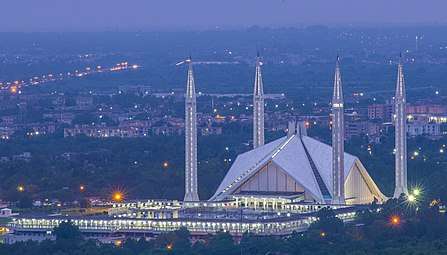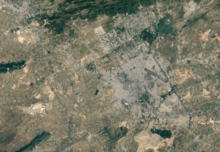Islamabad–Rawalpindi metropolitan area
The Islamabad–Rawalpindi metropolitan area is one of Pakistan's largest metropolitan areas. It consists principally of the twin cities of Islamabad and Rawalpindi, along with several gated suburbs including Bahria Town and DHA Islamabad.[4][5][6][7]
Islamabad–Rawalpindi metropolitan area | |
|---|---|
 | |
| Country | |
| Principal cities | Islamabad, Rawalpindi |
| Area | |
| • Total | 479 km2 (185 sq mi) |
| Rawalpindi:259 km² Islamabad:220 km² | |
| Population | |
| • Total | 3,113,056 |
| • Density | 6,500/km2 (17,000/sq mi) |
| Rawalpindi: 2,098,231 Islamabad: 1,014,825 | |
| Time zone | Pakistan Standard Time |
Covering the Pothohar Plateau, the area consists of the colonial city of Rawalpindi and the modern planned city of Islamabad.[8] The region received a major boom with the construction of Islamabad as the capital city of Pakistan in the 1960s.[9]
Geography

Islamabad and Rawalpindi are located in the Potohar region of northern Punjab, against the backdrop of the Margalla Hills.[10]
Economy
Islamabad is a net contributor to the Pakistani economy, as whilst having only 0.8% of the country's population, it contributes 1% to the country's GDP.[11] Islamabad Stock Exchange, founded in 1989, is Pakistan's third largest stock exchange after Karachi Stock Exchange and Lahore Stock Exchange, and was merged to form Pakistan Stock Exchange.[12] The exchange had 118 members with 104 corporate bodies and 18 individual members. The average daily turnover of the stock exchange is over 1 million shares.[13]
As of 2012, Islamabad LTU (Large Tax Unit) was responsible for Rs 371 billion in tax revenue, which amounts to 20% of all the revenue collected by Federal Board of Revenue.[14] Islamabad has seen an expansion in information and communications technology with the addition two Software Technology Parks, which house numerous national and foreign technological and information technology companies. The tech parks are located in Evacuee Trust Complex and Awami Markaz. Awami Markaz houses 36 IT companies while Evacuee Trust house 29 companies.[15]
The economy of Rawalpindi and the surrounding district has a diverse industrial base, but remains mainly service based. According to the general survey of industry conducted by Directorate of Industries and Mineral Development Punjab, there are 939 industrial units operating in the district. This district is not famous for industrial goods like other districts. The progress has been mostly in the private sector. The existing industrial units provide employment to about 35,000 people, i.e., about 1.6% of district population is directly employed in large, medium and small industrial units. The Technical/Vocational Training Institute operating in the district turns out about 1,974 technicians/artisans annually. They are trained in engineering, air conditioning, drafting, metallurgy, welding, auto knitting, telecom and commerce, etc. Jinnah Road, formerly known as City Saddar Road, is one of the busiest business markets. It could be considered as business headquarters northern Pakistan including retailers, wholesalers, distributors, manufacturers having an approximately cash flow of more than 1 billion rupees per day. The importance of Jinnah Road can be seen by the presence of more than nine banks on the road with more opening soon.[16] Being an expensive city, the prices of most of fruits, vegetable and poultry items increased in Islamabad during the year 2015-2020[17]
Infrastructure
The metro area is connected by a network of highway's with the rest of the country. Within the metro area the Islamabad Highway and Kashmir Highway provide the primary link between Islamabad and Rawalpindi. The area is divided by the Grand Trunk Road which connect's the region with Lahore and Peshawar. The newer, M2 Motorway contact's the area with Lahore, and through Lahore with the port city of Karachi.[18]
The area is also connected to the Pakistan Railway's national railway network. The area is served by Islamabad International Airport which is one of the largest airports in Pakistan, it has a capacity of serving 9million passengers per year which can be increased to up to 25million. The Civil Aviation Authority has plans to acquire more land for the development of the third Runway, It is the only airport in Pakistan capable of landing the Airbus A380.[19] The Rawalpindi-Islamabad Metrobus is a 24 km (14.9 mi) bus rapid transit system that serves the twin cities of Rawalpindi and Islamabad with the larger metropolitan area. It uses dedicated bus lanes for all of its route covering 24 bus stations.
Politics
As Pakistan's capital city, Islamabad serves as the seat of the federal government and is the country's political center. Rawalpindi has remained important historically, as it hosts the headquarters of Pakistan's army.[20] Rawalpindi also temporarily served as the federal capital when Islamabad was being built in the 1960s, to replace Karachi as the capital.[21]
Demographics
| Urban Area | Province | Population | Type |
|---|---|---|---|
| Islamabad | Islamabad Capital Territory | 1,014,825[22] | Capital city |
| Golra Sharif | Islamabad Capital Territory | 143,000 | Town |
| Nilore | Islamabad Capital Territory | 132,000 | Town |
| Defence | Islamabad Capital Territory (part), Punjab (part) | - | Gated community |
| Rawalpindi | Punjab | 2,098,231[22] | Major city |
| Bahria | Punjab | 120,000[23] | Gated community |
| Wah Cantonment | Punjab | 350,000[24] | Garrison Town /Cantonment Board |
| Taxila | Punjab | 677,951[25] | Town |
| Gujar Khan | Punjab | 678,503[25] | Town |
| Murree | Punjab | 233,471[25] | Hill station |
References
- http://rawalpindi.dc.lhc.gov.pk/PublicPages/HistoryOfDistrict.aspx
- http://www.pbs.gov.pk/content/district-glance-islamabad
- "Pakistan: Provinces and Major Cities - Population Statistics, Maps, Charts, Weather and Web Information". citypopulation.de.
- Raza, Syed Irfan (2012-08-07). "Islamabad's population touches two-million mark". DAWN.COM. Retrieved 2016-10-29.
- "Area & Population of Aadministrative Units". Pakistan Bureau of Statistics. Retrieved 2019-10-25.
- "Union Council Boundaries of Rawalpindi City and District". Pakistan GIS. February 2, 2012. Retrieved 2016-10-29.
- "A new era of modern transport begins". www.pid.gov.pk. Retrieved 2016-10-29.
- "Rawalpindi: History behind a bustling city". Retrieved 2016-10-29.
- Mass, Leslie Noyes (2011-10-15). Back to Pakistan: A Fifty-Year Journey. Rowman & Littlefield. p. 170. ISBN 9781442213197.
- Hull, Matthew S. Government of Paper: The Materiality of Bureaucracy in Urban Pakistan. University of California Press. p. 34. ISBN 9780520951884.
- Shahid Javed Burki (5 January 2010). "Economics and extremism". DAWN.COM. Archived from the original on 8 January 2010. Retrieved 2 June 2010.
- "Pakistan Stock Exchanges". Archived from the original on 2010-02-28. Retrieved 2016-11-22.
- "About ISE". Islamabad Stock Exchange. Archived from the original on 2011-06-17.
- "Rs 371bn revenue target: FBR hails LTU Islamabad's performance". Business Recorder. 5 July 2012. Retrieved 9 July 2012.
- Pakistan Software Export Board. "Islamabad". Archived from the original on 2010-05-05.
- "Furniture". Scribd. Retrieved 2016-09-24.
- "Retail Prices of Vegetables, Fruits and Poultry in Islamabad from 2015-2020". Deliver It - Online Grocery Store in Islamabad.
- "Pakistan Motorway Project". www.pakpost.gov.pk. Retrieved 2016-10-29.
- "Business Recorder". www.brecorder.com. Retrieved 2016-10-29.
- King, John S.; Mayhew, Bradley (1998). Karakoram Highway. Lonely Planet. p. 233. ISBN 9780864425317.
- Camerapix (1989). Spectrum Guide to Pakistan. Facts on File. p. 229. ISBN 9780816021260.
- "Provisional Summary Results of 6th Population and Housing Census-2017 | Pakistan Bureau of Statistics". www.pbs.gov.pk. Retrieved 2017-12-25.
- Ali, Fahim Zaman | Naziha Syed (2016-04-18). "Bahria Town Karachi: Greed unlimited". DAWN.COM. Retrieved 2016-10-29.
- Iqbal, Amjad (2015-04-29). "Wah Cantt election statistics reveal interesting trends". DAWN.COM. Retrieved 2016-10-29.
- "Provisional Summary Results of 6th Population and Housing Census-2017". http://www.pbscensus.gov.pk/ Archived 2017-10-15 at the Wayback Machine. Retrieved 2017-12-25.